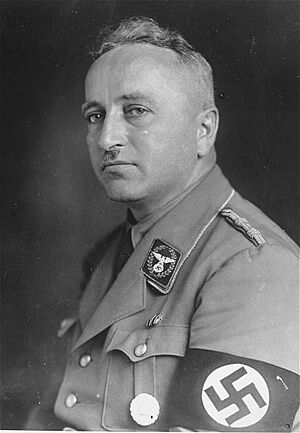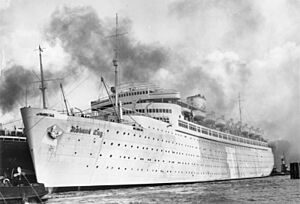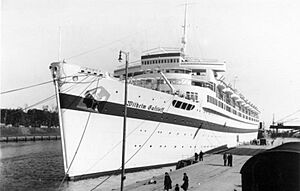Robert Ley facts for kids
Quick facts for kids
Robert Ley
|
|
|---|---|
 |
|
| Reich Organization Leader of the Nazi Party |
|
| In office 10 November 1934 – 8 May 1945 |
|
| Preceded by | Adolf Hitler |
| Succeeded by | Position abolished |
| Head of the German Labour Front | |
| In office 10 May 1933 – 8 May 1945 |
|
| Leader | Adolf Hitler |
| Preceded by | Position established |
| Succeeded by | Position abolished |
| Chief of Staff of the Reich Organization Leader of the Nazi Party | |
| In office 9 December 1932 – 10 November 1934 |
|
| Leader | Adolf Hitler |
| Preceded by | Gregor Strasser |
| Succeeded by | Position abolished |
| Gauleiter of Southern Rhineland, later Rhineland | |
| In office 17 July 1925 – 31 May 1931 |
|
| Preceded by | Heinrich Haake |
| Succeeded by | Position abolished |
| Additional positions | |
| 1940—1945 | Reichskommissar for Social Housing Construction |
| 1933—1945 | Member of the Prussian State Council |
| 1933–1945 | Reichsleiter of the Nazi Party |
| 1933–1945 | Member of the Greater German Reichstag |
| June – December 1932 | Reichsinspecteur of the Nazi Party |
| 1930–1933 | Member of the Reichstag |
| Personal details | |
| Born | 15 February 1890 Niederbreidenbach, Rhine Province, Prussia, German Empire |
| Died | 25 October 1945 (aged 55) Nuremberg Prison, Nuremberg, Allied-occupied Germany |
| Nationality | German |
| Political party | Nazi Party |
| Spouses |
Elisabeth Schmidt
(m. 1921; div. 1938)Inge Spilcker
(m. 1938; died 1942) |
| Children | 5 |
| Parents | Friedrich Ley Emilie Wald |
| Alma mater | Jena, Bonn, Münster |
| Known for | Head of the German Labour Front (1933–1945) |
| Military service | |
| Allegiance | |
| Branch/service | Imperial German Army |
| Years of service | 1914–1920 |
| Rank | Leutnant |
| Unit | 10th Foot Artillery Regiment |
| Battles/wars | World War I |
| Awards | Iron Cross 2nd class Wound Badge, in silver |
Robert Ley (born February 15, 1890 – died October 25, 1945) was an important German politician during the Nazi era. He led the German Labour Front (DAF) from 1933 to 1945. He also held many other high positions in the Nazi Party, such as a regional leader (Gauleiter) and a national leader (Reichsleiter). He died in 1945 while waiting for his trial at Nuremberg.
Contents
Early Life and Education
Robert Ley was born in Niederbreidenbach, Germany. He was the seventh of 11 children in a farming family. He studied chemistry at several universities, including Jena, Bonn, and Münster.
When World War I started in 1914, Ley joined the army. He served for two years in the 10th Foot Artillery Regiment. He fought on both the eastern and western fronts. In 1916, he became a lieutenant and trained to spot artillery targets from an airplane. In July 1917, his plane was shot down over France. He was taken as a prisoner of war. It is thought that he suffered a brain injury in the crash. For the rest of his life, he had a stammer and sometimes acted strangely. He received the Iron Cross, 2nd class, and the Wound Badge.
After the war, Ley was released in January 1920. He went back to university and earned his doctorate that year. He then worked as a food chemist for a large company called IG Farben.
Joining the Nazi Party
Ley became very angry about the French occupation of the Ruhr region in 1924. This led him to become a strong nationalist. He joined the Nazi Party after reading a speech by Adolf Hitler. Ley was always very loyal to Hitler. Because of this loyalty, Hitler often ignored complaints about Ley's behavior or mistakes.
Ley came from a poor background. He also led the Nazi Party in the Rhineland, which had many working-class people. This made him understand some of the ideas of the more worker-focused parts of the party. However, he always supported Hitler in any arguments within the party. This helped him keep his position even when other party officials disliked him.
Rise in the Nazi Party
Ley rejoined the Nazi Party in March 1925 after it was allowed to operate again. He quickly became a deputy regional leader (Gauleiter) for the Southern Rhineland. By July, he was promoted to Gauleiter for the whole Rhineland region.
In March 1928, Ley became the editor of an anti-Semitic Nazi newspaper called Westdeutscher Beobachter. He was elected to the Prussian state parliament (Landtag) in May 1928. He also became a member of the Rhenish provincial legislature. In September 1930, he was first elected to the German national parliament (Reichstag). He remained Gauleiter of Rhineland until June 1931.
In October 1931, Ley moved to the Nazi Party headquarters in Munich. He became the deputy to Gregor Strasser, who was in charge of party organization. Ley visited different regions (Gaue) to inspect them. In June 1932, he was made one of two national inspectors (Reichsinspecteurs). He oversaw about half of Germany's regions. When Strasser resigned in December 1932, Hitler took over party organization. Hitler made Ley his Chief of Staff.
When Hitler became the leader of Germany in January 1933, Ley moved to Berlin with him. In June 1933, Ley was promoted to Reichsleiter, which was the second-highest political rank in the Nazi Party. He was also appointed to the Prussian State Council. In November 1934, Hitler officially made Ley the Reichsorganisationsleiter, a position he held until the end of the Nazi regime.
Leading the German Labour Front

In April 1933, Hitler decided that the Nazi Party should control all trade unions. On May 10, 1933, Hitler appointed Robert Ley to lead the new German Labour Front (Deutsche Arbeitsfront, DAF). The DAF took over all existing trade unions.
At first, another leader named Reinhold Muchow had a lot of influence in the DAF. He removed former Social Democrats and Communists from the DAF administration. However, the DAF's actions in factories, like pushing for better wages, annoyed employers. They complained to Hitler.
Hitler did not like the idea of independent worker groups. In January 1934, a new law was passed that stopped independent factory organizations, even Nazi ones. This law put decisions about wages and conditions into the hands of "Trustees of Labour," who were mostly employers. At the same time, Muchow was removed, and Ley's control over the DAF was strengthened. The DAF then became a tool of the state. Its main job was to organize and control workers to help Germany's growing arms industry.
As head of the Labour Front, Ley invited Edward, Duke of Windsor, and his wife, Wallis, Duchess of Windsor, to visit Germany in 1937. This was months after Edward had given up the British throne. Ley was their host and traveled with them.
Once Ley's power was secure, he started to misuse it. Besides his high salaries, he took large profits from his newspaper and used DAF money for himself. By 1938, he owned a fancy estate, several villas, many cars, a private train car, and a large art collection. The DAF became known for its corruption, which was paid for by the required fees from German workers.
Strength Through Joy Program
Hitler and Ley knew that controlling trade unions and wages might make workers unhappy. To prevent this, in November 1933, the DAF created the Strength Through Joy (Kraft durch Freude, KdF) program. This program offered many benefits and activities to German workers and their families.
These benefits included affordable holidays at resorts in Germany and in other countries like Italy. Two of the world's first cruise ships, the Wilhelm Gustloff and the Robert Ley, were built for KdF members to go on cruises.
Other KdF programs included concerts and entertainment in factories. They also offered free physical education and sports training, such as football, tennis, and sailing. The DAF paid for all these activities, costing millions of German marks each year. This money came from workers' dues and contributions from employers. The KdF was one of the most popular Nazi programs. It helped make the working class more accepting of the Nazi government before 1939.
The DAF and KdF's biggest project was the "people's car," the Volkswagen. Hitler wanted a car that cost 1,000 German marks or less. When car companies couldn't meet this price, the DAF took over the project. Ley said the party stepped in where private companies failed. A new Volkswagen factory was built at Fallersleben. This cost a lot of money, partly taken from DAF funds and workers' dues. The Volkswagen was sold to German workers on an installment plan. The first models appeared in February 1939. However, when World War II started, none of the 340,000 workers who paid for a car ever received one.
Wartime Role
After World War II began in September 1939, Ley's importance decreased. The war effort meant that the DAF's role was reduced. The KdF program was also mostly stopped. Ley's unpredictable behavior was less tolerated during wartime. Other leaders, like Armaments Minister Albert Speer, became more important in managing the German workforce.
As German workers were sent to fight, foreign workers were brought in to replace them. These included "guest workers" from France and later forced laborers from Eastern Europe. Ley was involved in this program, but Fritz Sauckel became the main person in charge of labor distribution.
Ley was aware of the Nazi regime's plans to harm Jewish people. He supported these plans through his anti-Semitic writings and speeches. In April 1945, Ley became interested in a "death ray" idea from an inventor. He believed it would be a "decisive weapon." However, the parts needed for it were very old and no longer made.
Images for kids
See also
 In Spanish: Robert Ley para niños
In Spanish: Robert Ley para niños
- Glossary of Nazi Germany
- List of Nazi Party leaders and officials





